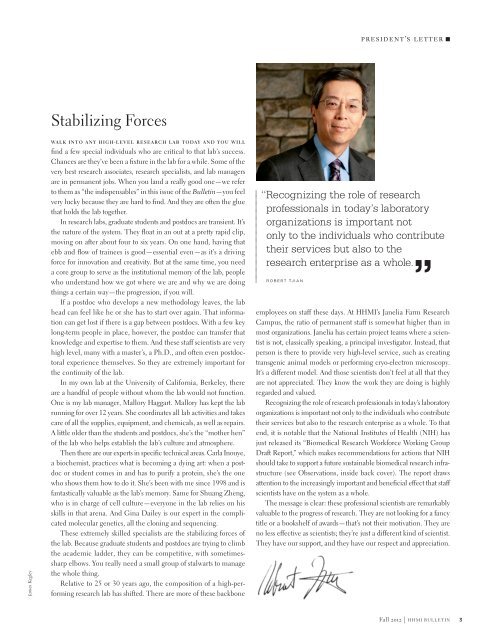Download PDF - Howard Hughes Medical Institute
Download PDF - Howard Hughes Medical Institute
Download PDF - Howard Hughes Medical Institute
You also want an ePaper? Increase the reach of your titles
YUMPU automatically turns print PDFs into web optimized ePapers that Google loves.
president’s letter<br />
Stabilizing Forces<br />
James Kegley<br />
Walk into any high-level research lab today and you will<br />
find a few special individuals who are critical to that lab’s success.<br />
Chances are they’ve been a fixture in the lab for a while. Some of the<br />
very best research associates, research specialists, and lab managers<br />
are in permanent jobs. When you land a really good one—we refer<br />
to them as “the indispensables” in this issue of the Bulletin—you feel<br />
very lucky because they are hard to find. And they are often the glue<br />
that holds the lab together.<br />
In research labs, graduate students and postdocs are transient. It’s<br />
the nature of the system. They float in an out at a pretty rapid clip,<br />
moving on after about four to six years. On one hand, having that<br />
ebb and flow of trainees is good—essential even—as it’s a driving<br />
force for innovation and creativity. But at the same time, you need<br />
a core group to serve as the institutional memory of the lab, people<br />
who understand how we got where we are and why we are doing<br />
things a certain way—the progression, if you will.<br />
If a postdoc who develops a new methodology leaves, the lab<br />
head can feel like he or she has to start over again. That information<br />
can get lost if there is a gap between postdocs. With a few key<br />
long-term people in place, however, the postdoc can transfer that<br />
knowledge and expertise to them. And these staff scientists are very<br />
high level, many with a master’s, a Ph.D., and often even postdoctoral<br />
experience themselves. So they are extremely important for<br />
the continuity of the lab.<br />
In my own lab at the University of California, Berkeley, there<br />
are a handful of people without whom the lab would not function.<br />
One is my lab manager, Mallory Haggart. Mallory has kept the lab<br />
running for over 12 years. She coordinates all lab activities and takes<br />
care of all the supplies, equipment, and chemicals, as well as repairs.<br />
A little older than the students and postdocs, she’s the “mother hen”<br />
of the lab who helps establish the lab’s culture and atmosphere.<br />
Then there are our experts in specific technical areas. Carla Inouye,<br />
a biochemist, practices what is becoming a dying art: when a postdoc<br />
or student comes in and has to purify a protein, she’s the one<br />
who shows them how to do it. She’s been with me since 1998 and is<br />
fantastically valuable as the lab’s memory. Same for Shuang Zheng,<br />
who is in charge of cell culture—everyone in the lab relies on his<br />
skills in that arena. And Gina Dailey is our expert in the complicated<br />
molecular genetics, all the cloning and sequencing.<br />
These extremely skilled specialists are the stabilizing forces of<br />
the lab. Because graduate students and postdocs are trying to climb<br />
the academic ladder, they can be competitive, with sometimessharp<br />
elbows. You really need a small group of stalwarts to manage<br />
the whole thing.<br />
Relative to 25 or 30 years ago, the composition of a high-performing<br />
research lab has shifted. There are more of these backbone<br />
“Recognizing the role of research<br />
professionals in today’s laboratory<br />
organizations is important not<br />
only to the individuals who contribute<br />
their services but also to the<br />
research enterprise as a whole.<br />
”<br />
Robert Tjian<br />
employees on staff these days. At HHMI’s Janelia Farm Research<br />
Campus, the ratio of permanent staff is somewhat higher than in<br />
most organizations. Janelia has certain project teams where a scientist<br />
is not, classically speaking, a principal investigator. Instead, that<br />
person is there to provide very high-level service, such as creating<br />
transgenic animal models or performing cryo-electron microscopy.<br />
It’s a different model. And those scientists don’t feel at all that they<br />
are not appreciated. They know the work they are doing is highly<br />
regarded and valued.<br />
Recognizing the role of research professionals in today’s laboratory<br />
organizations is important not only to the individuals who contribute<br />
their services but also to the research enterprise as a whole. To that<br />
end, it is notable that the National <strong>Institute</strong>s of Health (NIH) has<br />
just released its “Biomedical Research Workforce Working Group<br />
Draft Report,” which makes recommendations for actions that NIH<br />
should take to support a future sustainable biomedical research infrastructure<br />
(see Observations, inside back cover). The report draws<br />
attention to the increasingly important and beneficial effect that staff<br />
scientists have on the system as a whole.<br />
The message is clear: these professional scientists are remarkably<br />
valuable to the progress of research. They are not looking for a fancy<br />
title or a bookshelf of awards—that’s not their motivation. They are<br />
no less effective as scientists; they’re just a different kind of scientist.<br />
They have our support, and they have our respect and appreciation.<br />
Fall 2o12 | h h m i b u l l e t i n<br />
3
















